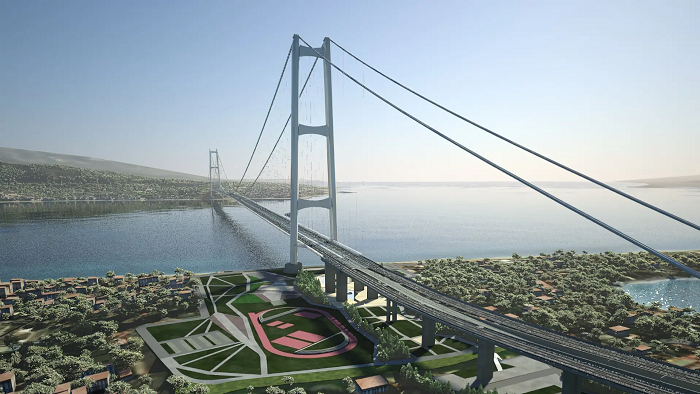ISABEL RUBIO ARROYO | Tungsteno
Connecting the Italian peninsula to the island of Sicily is the ambitious goal of the current Italian government. It intends to achieve this with the Strait of Messina Bridge, which, if built, would be one of the largest pieces of infrastructure of its kind in the world. Although the project has been attempted for decades without much success, the national government has revived it this year. We analyse the details of this majestic bridge that the Romans dreamed of two millennia ago.
A dream dating back to Roman times
In 252 BC, consul Lucius Caecilius Metellus strung together empty barrels and wooden planks to build a temporary bridge to transport 100 captured war elephants from Sicily to Rome, according to the writings of Pliny the Elder, as reported by CNN. Since then, there have been numerous attempts to link Italy and Sicily across the Strait of Messina. Now, this massive bridge could be on the verge of becoming a reality.
The Italian government has approved a decree to reactivate the project after almost two decades of paralysis. "The ones who won the 2006 tender are the ones who will most likely continue with the final version of the project," Deputy Prime Minister of Italy and Minister of Infrastructure and Transport Matteo Salvini told the Foreign Press Association in Rome in March 2023. At the time, the tender to build the bridge was awarded to a consortium led by the Italian company Salini Impregilo (now called WeBuild)of which Sacyr is a member.
"The bridge over the Strait of Messina is a project that can break ground immediately. As soon as the contract is reinstated and updated, the project can start," Michele Longo, WeBuild's engineering director, told the Italian parliament. He said they expected the executive design to take eight months and the bridge to take just over six years to build.
The bridge is often presented as one of the largest megastructures of its kind. Credit: WeBuild Group
The longest suspension bridge in the world
If built, the megastructure would span 3,200 metres, making it the longest suspension bridge in the world. "Its deck would be 61 metres wide, while the two towers on the shores would be 399 metres high," explains WeBuild. The bridge would have three vehicle lanes in each direction (two for regular traffic and a third for emergencies plus one for rail). In theory, "it would be able to support the crossing of six million vehicles and 60,000 trains a year, bringing Sicily's five million inhabitants closer to the rest of the continent."
WeBuild estimates that it will cost approximately €4.5 billion to build. "The cost of the bridge is equivalent to about 40% of the total for the infrastructure network that would accompany it," the company explains. The remaining 60% would be for related works. For example, the upgrading of the road and rail networks in Sicily and Calabria would reportedly cost around €5.3 billion. Other works, such as the construction of three rail stations in Messina and a central office in Calabria, and land preparation to reduce hydrogeological risks, would cost €1.1 billion.
If built, the Strait of Messina Bridge will be the longest suspension bridge in the world. Credit: WeBuild Group
Resistance to change and other challenges
What would the construction of this bridge mean for Sicily? "Since Italy was united in 1861, the bridge has been hailed as the saviour of the rural south, to bring it in step with the industrialised north and the rest of Europe," Aurelio Angelini, professor of sociology at the University of Palermo and author of The Mythical Bridge on the Strait of Messina, tells Wired magazine. But in reality, the project has been opposed by some locals on economic, political and environmental grounds. And according to Angelini, there is another important reason: resistance to change. "Sicilians and Calabrians are divided, but the majority are against the bridge. Some don’t want to give up traversing by ferry, because anthropologically that is what has always represented the connection to the Continent," he says.
The bridge’s construction comes with some major challenges. "The main problem is the wind," says Giuseppe Muscolino, a professor of engineering at the University of Messina. But he insists the design has been perfected in a wind tunnel and he believes it can be built safely and successfully. Its proponents say the bridge will withstand both earthquakes (up to 7.5 on the Richter scale) and strong winds of up to 300 kilometres per hour. "If [the wind] gets too severe, vehicle access might need to be closed for a few hours, but that kind of event happens every five or 10 years, and it usually stops ferry traffic too," says Enzo Siviero, an engineer and bridge designer behind the project.
The bridge would have three vehicle lanes in each direction, plus one for rail. Credit: WeBuild Group
According to Italy's Ministry of Infrastructure and Transport, the bridge "represents an important driver of the national economy and one of the strategic corridors in the EU’s economic policy". Salvini believes that at this stage, "it is less expensive to build the bridge than not to build it" and has promised that construction will start by the summer of 2024. Will the mega-bridge that the Romans dreamed of ever become a reality? That dream seems to be a little closer to becoming a reality.
Tungsteno is a journalism laboratory to scan the essence of innovation.
